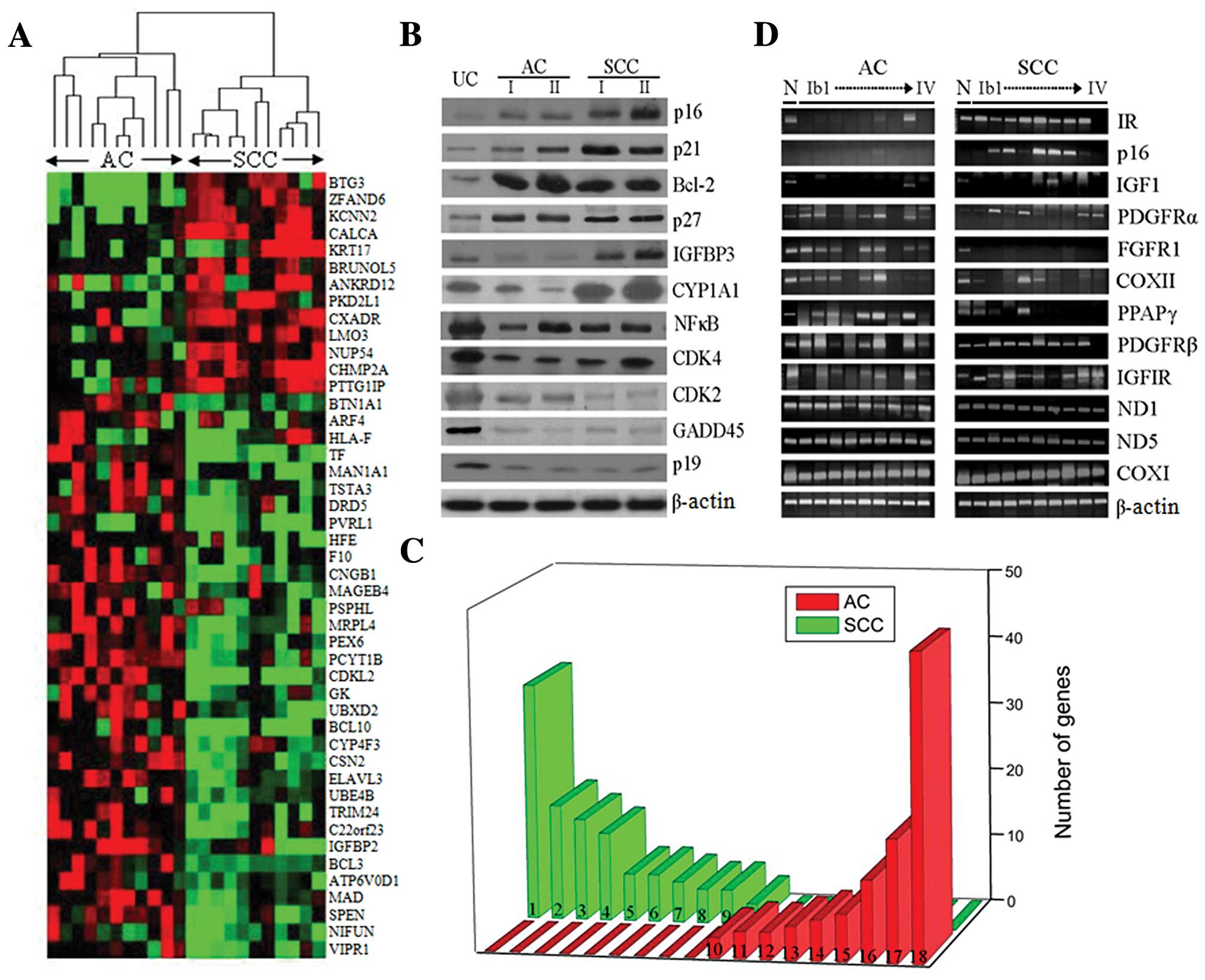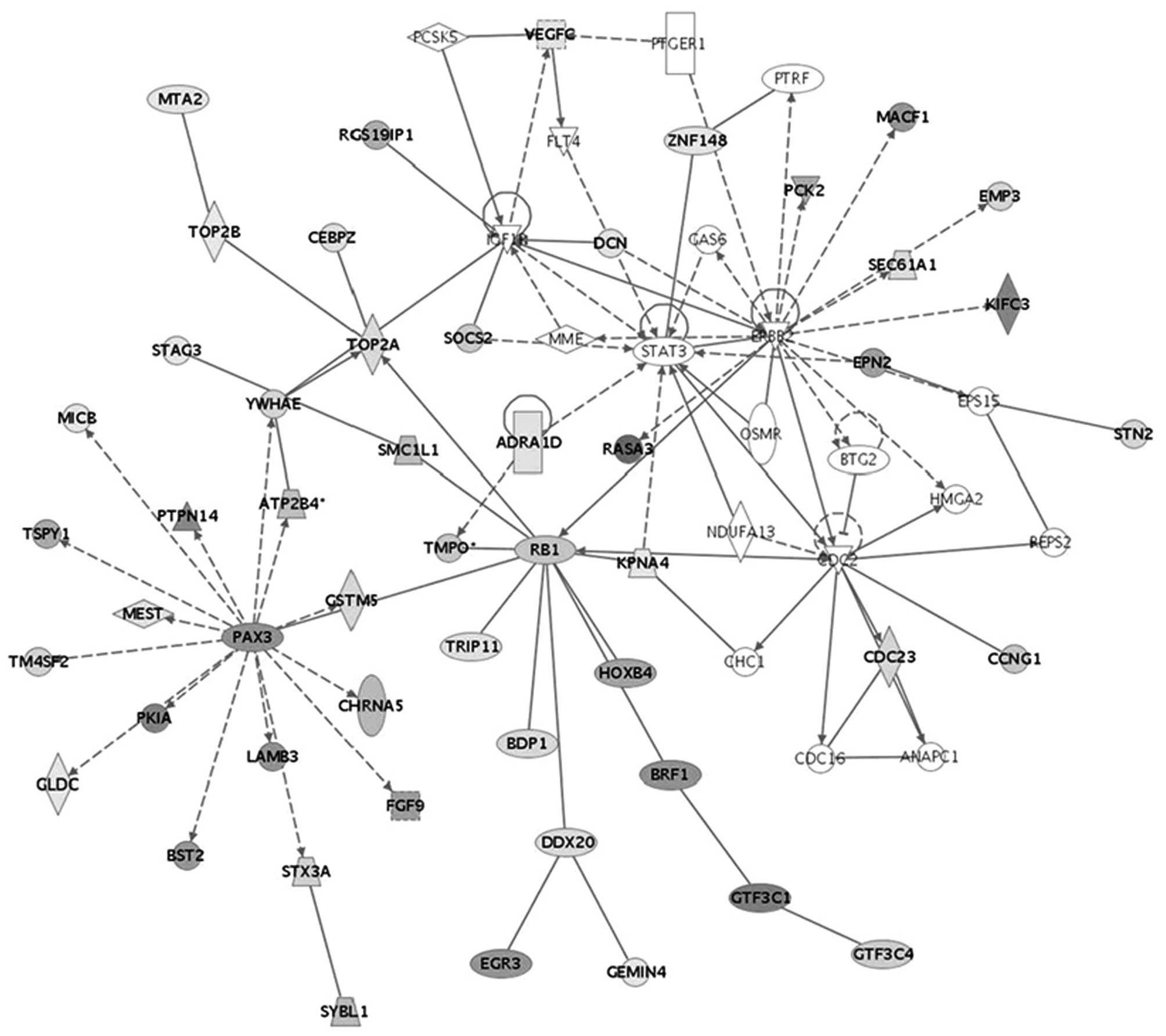|
1.
|
Bulk S, Visser O, Rozendaal L, Verheijen
RH and Meijer CJ: Cervical cancer in the Netherlands 1989–1998:
decrease of squamous cell carcinoma in older women, increase of
adenocarcinoma in younger women. Int J Cancer. 113:1005–1009.
2005.
|
|
2.
|
International Collaboration of
Epidemiological Studies of Cervical Cancer: Comparison of risk
factors for invasive squamous cell carcinoma and adenocarcinoma of
the cervix: collaborative reanalysis of individual data on 8,097
women with squamous cell carcinoma and 1,374 women with
adenocarcinoma from 12 epidemiological studies. Int J Cancer.
120:885–891. 2007. View Article : Google Scholar
|
|
3.
|
Ciapponi A, Bardach A, Glujovsky D,
Gibbons L and Picconi MA: Type-specific HPV prevalence in cervical
cancer and high-grade lesions in Latin America and the Caribbean:
systematic review and meta-analysis. PLoS One. 6:e254932011.
View Article : Google Scholar : PubMed/NCBI
|
|
4.
|
Clifford GM, Smith JS, Plummer M, Munoz N
and Franceschi S: Human papillomavirus types in invasive cervical
cancer worldwide: a meta-analysis. Br J Cancer. 88:63–73. 2003.
View Article : Google Scholar : PubMed/NCBI
|
|
5.
|
Castellsague X, Diaz M, de Sanjose S, et
al: Worldwide human papillomavirus etiology of cervical
adenocarcinoma and its cofactors: implications for screening and
prevention. J Natl Cancer Inst. 98:303–315. 2006. View Article : Google Scholar
|
|
6.
|
Plummer M, Herrero R, Franceschi S, et al:
Smoking and cervical cancer: pooled analysis of the IARC
multi-centric case-control study. Cancer Causes Control.
14:805–814. 2003. View Article : Google Scholar : PubMed/NCBI
|
|
7.
|
Wingo SN, Gallardo TD, Akbay EA, et al:
Somatic LKB1 mutations promote cervical cancer progression. PLoS
One. 4:e51372009. View Article : Google Scholar : PubMed/NCBI
|
|
8.
|
Wessels JM, Edwards AK, Zettler C and
Tayade C: Selection and validation of reference genes for miRNA
expression studies during porcine pregnancy. PLoS One.
6:e289402011. View Article : Google Scholar : PubMed/NCBI
|
|
9.
|
Yang IV, Chen E, Hasseman JP, et al:
Within the fold: assessing differential expression measures and
reproducibility in microarray assays. Genome Biol.
3:research00622002.PubMed/NCBI
|
|
10.
|
Bae SM, Lee CH, Cho YL, et al:
Two-dimensional gel analysis of protein expression profile in
squamous cervical cancer patients. Gynecol Oncol. 99:26–35. 2005.
View Article : Google Scholar : PubMed/NCBI
|
|
11.
|
Smedts F, Ramaekers F, Troyanovsky S, et
al: Basal-cell keratins in cervical reserve cells and a comparison
to their expression in cervical intraepithelial neoplasia. Am J
Pathol. 140:601–612. 1992.PubMed/NCBI
|
|
12.
|
Zumkeller W: IGFs and IGFBPs: surrogate
markers for diagnosis and surveillance of tumour growth? Mol
Pathol. 54:285–288. 2001. View Article : Google Scholar : PubMed/NCBI
|
|
13.
|
Reubi JC: In vitro identification of
vasoactive intestinal peptide receptors in human tumors:
implications for tumor imaging. J Nucl Med. 36:1846–1853. 1995.
|
|
14.
|
Nakanuma Y, Kouda W, Nakano T, Uneno K,
Tachibana S and Araki I: A case report of early idiopathic portal
hypertension. Pathol Res Pract. 197:759–767. 2001. View Article : Google Scholar : PubMed/NCBI
|
|
15.
|
Iizuka N, Oka M, Yamada-Okabe H, et al:
Comparison of gene expression profiles between hepatitis B virus-
and hepatitis C virus-infected hepatocellular carcinoma by
oligonucleotide microarray data on the basis of a supervised
learning method. Cancer Res. 62:3939–3944. 2002.
|
|
16.
|
Wyllie AH: Apoptosis and carcinogenesis.
Eur J Cell Biol. 73:189–197. 1997.
|
|
17.
|
Dixon BP, Henry J, Siroky BJ, Chu A, Groen
PA and Bissler JJ: Cell cycle control and DNA damage response of
conditionally immortalized urothelial cells. PLoS One.
6:e165952011. View Article : Google Scholar : PubMed/NCBI
|
|
18.
|
Luk SC, Siu SW, Lai CK, Wu YJ and Pang SF:
Cell cycle arrest by a natural product via G2/M checkpoint. Int J
Med Sci. 2:64–69. 2005. View Article : Google Scholar : PubMed/NCBI
|
|
19.
|
Choi HJ, Fukui M and Zhu BT: Role of
cyclin B1/Cdc2 up-regulation in the development of mitotic
prometaphase arrest in human breast cancer cells treated with
nocodazole. PLoS One. 6:e243122011. View Article : Google Scholar : PubMed/NCBI
|
|
20.
|
Gao Q, Srinivasan S, Boyer SN, Wazer DE
and Band V: The E6 oncoproteins of high-risk papillomaviruses bind
to a novel putative GAP protein, E6TP1, and target it for
degradation. Mol Cell Biol. 19:733–744. 1999.PubMed/NCBI
|
|
21.
|
Arai H, Ueno T, Tangoku A, et al:
Detection of amplified oncogenes by genome DNA microarrays in human
primary esophageal squamous cell carcinoma: comparison with
conventional comparative genomic hybridization analysis. Cancer
Genet Cytogenet. 146:16–21. 2003. View Article : Google Scholar
|
|
22.
|
Schneider G, Weber A, Zechner U, et al:
GADD45alpha is highly expressed in pancreatic ductal adenocarcinoma
cells and required for tumor cell viability. Int J Cancer.
118:2405–2411. 2006. View Article : Google Scholar : PubMed/NCBI
|
|
23.
|
Parvaresch S, Yesilkaya T, Baer K,
Al-Hasani H and Klein HW: 14-3-3 binding to the IGF-1 receptor is
mediated by serine auto-phosphorylation. FEBS Lett. 532:357–362.
2002. View Article : Google Scholar : PubMed/NCBI
|
|
24.
|
Nakamura K, Hongo A, Kodama J, Miyagi Y,
Yoshinouchi M and Kudo T: Down-regulation of the insulin-like
growth factor I receptor by antisense RNA can reverse the
transformed phenotype of human cervical cancer cell lines. Cancer
Res. 60:760–765. 2000.
|
|
25.
|
Spence SL, Dey BR, Terry C, Albert P,
Nissley P and Furlanetto RW: Interaction of 14-3-3 proteins with
the insulin-like growth factor I receptor (IGFIR): evidence for a
role of 14-3-3 proteins in IGFIR signaling. Biochem Biophys Res
Commun. 312:1060–1066. 2003. View Article : Google Scholar : PubMed/NCBI
|
|
26.
|
Fu H, Subramanian RR and Masters SC:
14-3-3 proteins: structure, function, and regulation. Annu Rev
Pharmacol Toxicol. 40:617–647. 2000. View Article : Google Scholar
|
|
27.
|
Craparo A, Freund R and Gustafson TA:
14-3-3 (epsilon) interacts with the insulin-like growth factor I
receptor and insulin receptor substrate I in a
phosphoserine-dependent manner. J Biol Chem. 272:11663–11669. 1997.
View Article : Google Scholar : PubMed/NCBI
|
|
28.
|
Takashima T, Fujiwara Y, Higuchi K, et al:
PPAR-γ ligands inhibit growth of human esophageal adenocarcinoma
cells through induction of apoptosis, cell cycle arrest and
reduction of ornithine decarboxylase activity. Int J Oncol.
19:465–471. 2001.
|
|
29.
|
Yang WL and Frucht H: Activation of the
PPAR pathway induces apoptosis and COX-2 inhibition in HT-29 human
colon cancer cells. Carcinogenesis. 22:1379–1383. 2001. View Article : Google Scholar : PubMed/NCBI
|
|
30.
|
Hall JM and McDonnell DP: The molecular
mechanisms underlying the proinflammatory actions of
thiazolidinediones in human macrophages. Mol Endocrinol.
21:1756–1768. 2007. View Article : Google Scholar : PubMed/NCBI
|
|
31.
|
Chawla A, Barak Y, Nagy L, Liao D,
Tontonoz P and Evans RM: PPAR-gamma dependent and independent
effects on macrophage-gene expression in lipid metabolism and
inflammation. Nat Med. 7:48–52. 2001. View
Article : Google Scholar : PubMed/NCBI
|
|
32.
|
Marx N, Kehrle B, Kohlhammer K, et al:
PPAR activators as anti-inflammatory mediators in human T
lymphocytes: implications for atherosclerosis and
transplantation-associated arteriosclerosis. Circ Res. 90:703–710.
2002. View Article : Google Scholar : PubMed/NCBI
|
|
33.
|
Shankaranarayanan P and Nigam S: IL-4
induces apoptosis in A549 lung adenocarcinoma cells: evidence for
the pivotal role of 15-hydroxyeicosatetraenoic acid binding to
activated peroxisome proliferator-activated receptor gamma
transcription factor. J Immunol. 170:887–894. 2003. View Article : Google Scholar
|
|
34.
|
Eichele K, Ramer R and Hinz B:
R(+)-methanandamide-induced apoptosis of human cervical carcinoma
cells involves a cyclo oxygenase-2-dependent pathway. Pharm Res.
26:346–355. 2009.
|












